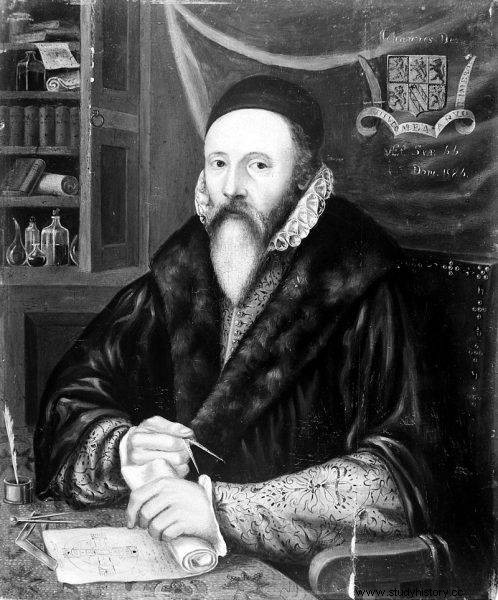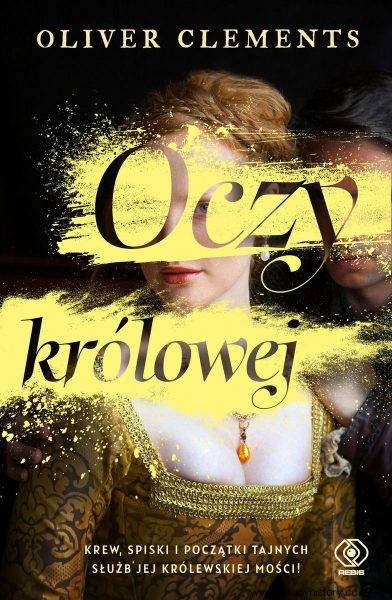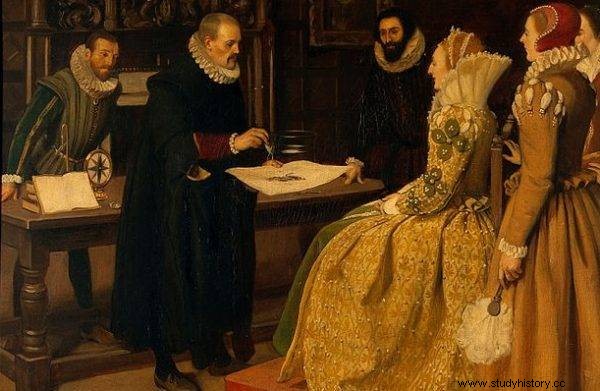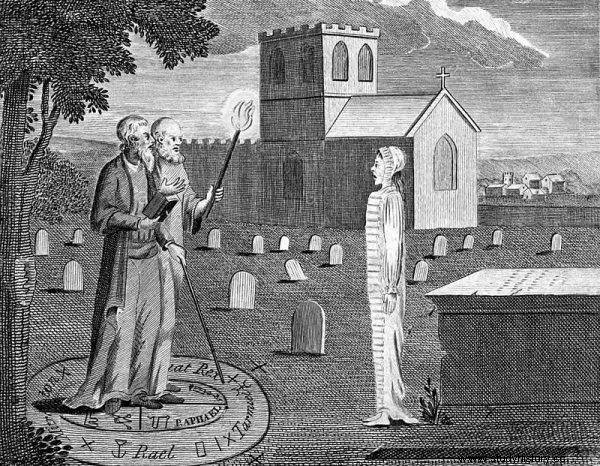It could be considered a cross between James Bond and ... the wizard Merlin. John Dee was Elizabeth I's spy, alchemist and occultist. He presented his magic tricks, among others at the court of Stefan Batory. Soon after the mage's visit, the monarch died. Did Renaissance Agent 007 have any fingers in it?
He signed his reports with the code name "007", and his supervisor placed only the letter "M" under the letters. Sounds familiar? The story of Queen Elizabeth I's spy, in fact, 400 years later inspired Ian Flaming to create the character of James Bond. However, John Dee - unlike Agent 007 - did not have high-tech gadgets.
But he had something much better up his sleeve. Magic.
Prince of mathematicians
John Dee was born the son of a Welsh merchant in 1527 in London. Even in his youth, he showed an extraordinary talent for learning. He was educated at Cambridge (as he himself wrote:"he devoted himself to research and science" - reportedly spent 18 hours a day on books!). He was a member of the prestigious Tinity College, and later studied, inter alia, in Brussels and Leuven.
At the age of only 23, he was invited to the University of Paris, where he was to teach Euclidean geometry. The students banged on doors and windows at his classes - literally, because those for whom there was no room in the auditorium climbed the wall to at least glance at the extraordinary guest. Even then, Dee was "regarded throughout Europe as a learned mathematician, and even as a prince of mathematicians of his time."

Dee was "regarded throughout Europe as a learned mathematician and even as a prince of mathematicians of his time."
However, he was interested not only in mathematics. He was one of the first English supporters of the Nicolaus Copernicus theory. He was also passionate about medicine, history, cryptology, the art of navigation and ... alchemy and astrology. And it was these latter areas that would make him famous as the most mysterious figure of Elizabethan England.
Great Sorcerer
It was the first time that rumors that John Dee was engaged in witchcraft had surfaced at Maria Tudor's court. A little later, the then historian John Foxe, in his work Acts and Monuments in 1563 described him as "the great sorcerer." And all because the scientist gave the ruler a horoscope. Apparently not what she wanted.
We do not know the exact wording of the unflattering prophecy. What she might have looked like is described in the novel "The Queen's Eyes" by Oliver Clements:
The sun in Pisces, the Moon in Virgo, Mars in Capricorn. The Queen was tough, cold, and efficient, especially quick-tempered. He presented these features in a milder form. The mistress was a numb, moreover, he did not see any children in her future. However, he kept the information on the latter to himself. But then he made a mistake.

The text was inspired by Oliver Clements's novel "Eyes of the Queen", which has just been released by Rebis.
Princess Elizabeth asked him to show his sister's chart, and he succumbed to her. (...). A rumor spread, and it was soon concluded that Dee had extremely sinister intentions, that he had cast an evil spell on the children, cursed the mistress of the house, that she planned to kill the queen and replace her with Princess Elizabeth.
The result was that the unfortunate astrologer, accused of treason and dealing with unclean forces, was briefly arrested in 1555 . He managed to defend himself before a royal court and an ecclesiastical tribunal, but the label of a sorcerer stuck to him for the rest of his life.
And in fact, it is hardly surprising considering the further course of his career.
Queen's pet
After his release from prison, John Dee quickly regained his position at court. He was valued as a teacher, sailors' advisor, geographer, constructor and bibliophile (in his residence in Mortlake near London he had a library of over 4,000 volumes; he also had his own study of curiosities and an alchemy workshop there). Henryk Zins writes:
He did not spare the royal court of England and Elizabeth I herself who gave him gifts and sinecures. As chief court astrologer, it was Dee who chose (...) the day for Elizabeth's coronation.
John Dee was consulted by the greatest explorers and explorers of the Elizabethan era before embarking on long journeys, politicians and diplomats in matters requiring, in particular, knowledge of ancient history. In 1583 the English court entrusted him with the reform of the calendar.

The royal court of England and Elizabeth I herself who gave him gifts and sinecures did not spare him the proofs of recognition.
The queen also expressed her favors, guaranteeing John the freedom to conduct research in the field of magic, occultism and broadly understood "secret knowledge". As he himself emphasized, the ruler assured him:
security to any kingdom that is subject to it who, because of my extraordinary studies and philosophical research, would wrongly want to bring me down.
Like an angel's voice
The irony of fate wanted him to fall down not by opponents of witchcraft, but by his own "magic" associate, Edward Kelley, who - as he himself claimed - was a medium and could talk to angels. Hanna Widacka reports:
While Dee remained a learned and honest seeker of truth at heart, his assistant Edward Kelley (1555–1595), an alchemist-apothecary, was a typical trickster and a trickster, "evil spirit" of the magician, a character at least suspicious . His real name was Talbot.
Caught falsifying notarial deeds, he was sentenced to have his ears cut. Wandering around England and begging under an assumed name, he had the nerve to creep in trust and the grace of John Dee. From then on he became a young scholar and assistant to the master.

However, while Dee remained at heart a learned and honest seeker of truth, his assistant Edward Kelley (1555–1595), an apothecary-alchemist, was a typical trickster and a fraud, "evil spirit"
The gentlemen went on a journey to the continent together. Officially, to conduct spiritualist sessions and present angelic dialogues in front of the crowned heads of Europe. They even managed to interest Emperor Rudolf II Habsburg with their abilities. Earlier, they also tried their luck at the court of the Polish ruler Stefan Batory.
Although the king - reluctantly, because reluctantly - received the magicians in Niepołomice, he did not believe in the mumbling "message from God" spoken through Kelley's lips. He paid the sorcerers eight hundred florins for their trouble and sent them away. When Batory died shortly after, it was immediately speculated that John Dee and Kelley were not involved in it. There were voices about the curse, and some suggested that the English poisoned the monarch on the orders of Elizabeth I.
The results of research conducted at the Jagiellonian University contradict these sensational theses - according to experts in forensics, the ruler died of kidney disease, which developed from an untreated cold.
In the service of Her Majesty
However, it is not entirely true that John Dee left Poland empty-handed. And it's not about 800 florins from Batory. As Zins writes:
Some researchers, incl. R. Żelewski, put forward the assumption that John Dee's journey to Poland and the Czech Republic was then mainly of a spy character, and the occult and alchemical experiences were only a kind of camouflage, as was the orchestrated sudden escape of John Dee and Edward Kelley accompanied by the indebted Olbracht Łaski to England in 1583.

The text was inspired by Oliver Clements's novel "Eyes of the Queen", which has just been released by Rebis.
The last of the men, Olbracht Łaski, was to be the initiator of the entire undertaking. This Polish nobleman and adventurer came to the English court to meet the famous mathematician and astrologer. His presence was decided to be used by Queen Elizabeth, who had been receiving disturbing news from the Vistula for some time about Batory's alleged contacts with the legation of Philip II, the ruler of Spain.
To get first-hand information about Polish foreign policy, she sent her trusted advisor on a spy mission. John thus became Her Majesty's agent and signed the reports as "007".
The Fall of Queen Merlin
The streak could not, however, last forever. Rumors of witchcraft (after all, he was called the Queen's Merlin for a reason, in honor of the sorcerer of Arthurian legends) and contacts with the charlatan Kelley hit John Dee with hiccups when Elizabeth I died in 1603, and the superstitious James I Stuart sat on the throne.
I submit myself to the death penalty (be it stoning, burying alive or burning without mercy) if it turns out that the name of a Sorcerer, Summoner, or Conjurer of devils or cursed spirits is proven to me .
His appeals, however, were unsuccessful. He spent the last years in poverty. He died at the age of 81. It took centuries for posterity to clear his name and acknowledge merits other than that of inventing the name "British Empire".
What happened to Kelley? He never returned from a tour of Central Europe. When Dee decided to return to England, his associate decided to stay in the Czech Republic. There he led the life of an adventurer and a charlatan, and when he was imprisoned, he took it himself.
Inspiration:
- O. Clements, The Queen's Eyes , Rebis 2021.
